

Online-assessment.pdf. Index. Examples of Formative Assessment. When incorporated into classroom practice, the formative assessment process provides information needed to adjust teaching and learning while they are still happening.
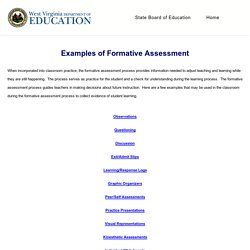
The process serves as practice for the student and a check for understanding during the learning process. The formative assessment process guides teachers in making decisions about future instruction. Web tools to support inquiry based learning. Peerstudio: Go beyond a gradebook with deep peer feedback that arrives in minutes, not days. Selecting Assessment Technologies. National Institute for Learning Outcomes Assessment.
Analysis of Examples of Good Assessment Practice: To learn more about what colleges and universities are doing to use assessment data productively to inform and strengthen undergraduate education, NILOA conducted nine case studies.
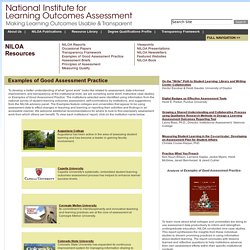
This report synthesizes the insights from these individual studies to discern promising practices in using information about student learning. The report concludes with lessons learned and reflective questions to help institutions advance their own assessment efforts within their specific institutional contexts. To read the report, click here. Additional Case Study Resources: Banta, T.W., & Associates. (2002). Banta, T. Banta, T. Bresciani, M. Bresciani, M. Assessing Student Learning - five practical guides. The issue of workload is central in any decisions about assessment of large classes for it is a serious one for students and staff alike.
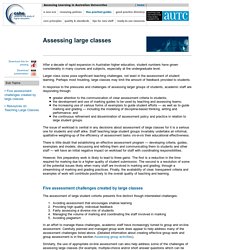
Staff teaching large student groups invariably undertake an informal, qualitative weighing-up of the efficiency of assessment tasks vis-à-vis their educational effectiveness. There is little doubt that establishing an effective assessment program — developing criteria, guides, exemplars and models; discussing and refining them and communicating them to students and other staff — will have an initial negative impact on workload for staff with coordinating responsibilities. However, this preparatory work is likely to lead to three gains. The first is a reduction in the time required for marking due to a higher quality of student submission.
The second is a resolution of some of the potential issues likely when many staff are involved in marking and grading, through a streamlining of marking and grading practices. Transforming Assessment. GaryVelan.pdf. The Benefits of Using Online Assessments. With the end of the year setting in, you may be in the midst of assessment season.

Or maybe you’re getting everything ready for your class assessments directly after the Christmas break. Setting up assessments can be a complicated and time consuming activity for teachers and trainers, so you may want to take a look at some different techniques which might make your life a little bit easier. One way of changing up the way you administer your final tests or exams could be to use online assessments. You may already be making your students complete their course work online, or do required reading online, so why not let them complete assessments that way too? There are lots of tools which means you can create online assessments, many of which are free depending on how many assessments you need to create, or how complex they are going to be, so it’s important to have a look around and see which tools you think would work best for your course content.
Less Preparation Less Work Afterwards. Viewcontent. Assessing Student Learning - five practical guides. ‘If lower-order learning is an unintended educational consequence of on-line assessment, then any perceived or real gains made in efficiency, staff workload reduction and/or cost savings are at a questionable price.’
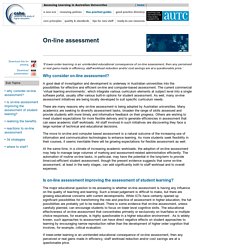
Onlineed.pdf. Assessing Student Learning - core principles. Enhancing learning by enhancing assessment Assessment is a central element in the overall quality of teaching and learning in higher education.
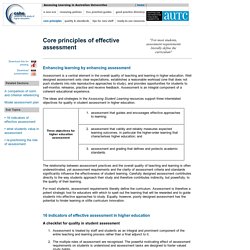
Well designed assessment sets clear expectations, establishes a reasonable workload (one that does not push students into rote reproductive approaches to study), and provides opportunities for students to self-monitor, rehearse, practise and receive feedback. Formative vs Summative Assessment. Formative assessment The goal of formative assessment is to monitor student learning to provide ongoing feedback that can be used by instructors to improve their teaching and by students to improve their learning.
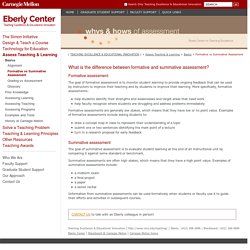
More specifically, formative assessments: help students identify their strengths and weaknesses and target areas that need workhelp faculty recognize where students are struggling and address problems immediately Formative assessments are generally low stakes, which means that they have low or no point value. Using-assessment-to-support-student-learning.pdf. Choosing appropriate assessment. Vary assessmentsStudent learning styles vary widely, and their strengths and challenges with respect to assessment vary as well.
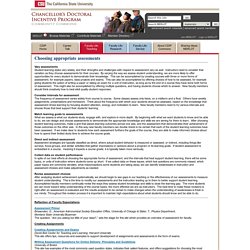
Instructors need to consider that variation as they choose assessments for their courses. By varying the way we assess student understanding, we are more likely to offer opportunities for every student to demonstrate their knowledge. This can be accomplished by creating courses with three or more forms of assessment, for example papers, class projects and exams. This can also be accomplished by offering choices of how to be assessed, for example giving students the option of writing a paper or taking an exam for a unit of instruction, as long as by the end of a course they have done both forms of assessment. This might also be accomplished by offering multiple questions, and having students choose which to answer.
E-Guide: E-Tutoring: Designing and supporting online learning. Introduction E-tutoring can be defined as teaching, support, management and assessment of students on programmes of study that involve a significant use of online technologies (TechLearn, 2000).
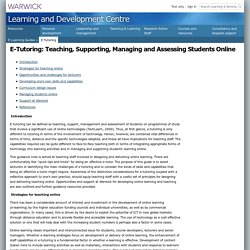
Thus, at first glance, e-tutoring is only different to tutoring in terms of the involvement of technology. Herein, however, are contained vital differences in terms of time, distance and the specific technologies adopted, and these all have implications for teaching staff. Www.jisc.ac.uk/media/documents/programmes/elearning/digiassass_eada.pdf. Technology-supported assessment. Initial Author David Nicol Background and Definitions Assessment is a complex process in formal learning contexts.
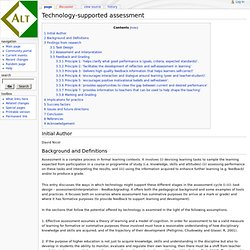
It involves (i) devising learning tasks to sample the learning expected from participation in a course or programme of study (i.e. knowledge, skills and attitudes) (ii) assessing performance on these tasks and interpreting the results, and (iii) using the information acquired to enhance further learning (e.g. feedback) and/or to produce a grade. This entry discusses the ways in which technology might support these different stages in the assessment cycle (i-iii): task design – assessment/interpretation - feedback/grading. In the sections that follow the potential offered by technology is examined in the light of the following assumptions. Aligning assessment with long term learning - Boud and Falchikov.
26 Teacher Tools To Create Online Assessments. UNSW Assessment as Learning Toolkit. Selecting Assessment Methods. Determine the optimum mixture of assessment tasks At the course level, an assessment plan that comprises several different components or tasks will increase the likelihood that students experience at least one task type that suits their preferred learning style.
UCD Teaching & Learning - A-Z of Downloadable Resources. Assessment for Learning - OER in Education. Research shows that good practice in assessment for learning can bring about significant gains in pupil attainment About. This study unit offers practical strategies that teachers can use to improve their understanding of assessment for learning. Assessment for learning is key because it is a powerful means to help tailor teaching to motivate and involve pupils to take their next step in learning. The techniques suggested are tried and tested; draw on academic research and teaching experience.
The unit aims to build a teaching repertoire and reflect on practice. Pedagogical content. For some shorter more focused documents drawn from this DfES document see Giving Oral Feedback, Giving Written Feedback, Sharing Learning Objectives and Outcomes. Welcome to Dylan Wiliam’s website. Professional development Finally! The revised Embedding formative assessment pack for schools and colleges to run their own two-year professional development programme on formative assessment is now available worldwide. In Europe, this can be ordered through SSAT, in Australasia through Hawker-Brownlow, and in North America from Learning Sciences International.
Further details of the pack are here. Also, a series of high-quality video presentations by Dylan Wiliam, with a total running time of over two and a half hours, is now available world-wide.